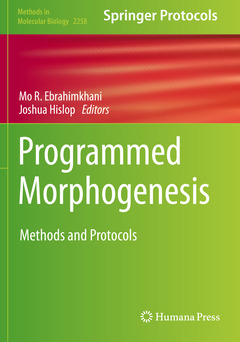Description
Programmed Morphogenesis, 1st ed. 2021
Methods and Protocols
Methods in Molecular Biology Series, Vol. 2258
Language: English
Subjects for Programmed Morphogenesis:
Publication date: 12-2021
286 p. · 17.8x25.4 cm · Paperback
Publication date: 12-2020
286 p. · 17.8x25.4 cm · Hardback
Description
/li>Contents
/li>Comment
/li>
Part I: Understanding Signaling Events and Patterns
1. TASBE Image Analytics: A Processing Pipeline for Quantifying Cell Organization from Fluorescent Microscopy
Nicholas Walczak, Jacob Beal, Jesse Tordoff, and Ron Weiss
2. Neighborhood Impact Factor to Study Cell-Fate Decision-Making in Cellular Communities
Shay Carter, Joshua Hislop, Joshua Hsu, Jeremy J. Velazquez, and Mo R. Ebrahimkhani
3. A Quantitative Lineage-Tracing Approach to Understand Morphogenesis in Gut
Svetlana Ulyanchenko and Jordi Guiu
Part II: Programming Signaling Events and Patterns
4. Reconstitution of Morphogen Signaling Gradients in Cultured Cells
Julia S. Kim, Michael Pineda, and Pulin Li
5. Engineering Shape-Controlled Microtissues on Compliant Hydrogels with Tunable Rigidity and Extracellular Matrix Ligands
Megan L. Rexius-Hall, Nethika R. Ariyasinghe, and Megan L. McCain
6. Engineering Biophysical Cues for Controlled 3D Differentiation of Endoderm Derivatives
Thomas Richardson, Shibin Mathew, Connor Wiegand, Kevin Pietz, Joseph Candiello, K Ravikumar, and Ipsita Banerjee
7. Rewiring Endogenous Bioelectric Circuits in the Xenopus laevis Embryo Model
Vasilios Nanos and Michael Levin
8. Engineering the Spatiotemporal Mosaic Self-Patterning of Pluripotent Stem Cells
Ashley R.G. Libby, David A. Joy, and Todd C. McDevitt
Part III: Early Developmental Engineering
9. Fate-Patterning of 2D Gastruloids and Ectodermal Colonies Using Micropatterned Human Pluripotent Stem Cells
George Britton, Sapna Chhabra, Joseph Massey, and Aryeh Warmflash
10. Gastruloids: Embryonic Organoids from Mouse Embryonic Stem Cells to Study Patterning and Development in Early Mammalian Embryos
Kerim Anlas, Peter Baillie-Johnson, Krisztina Arató, David A. Turner, and Vikas Trivedi
Part IV: Organoids, Tissue Barriers, and Disease Models
11. A Synergistic Engineering Approach to Build Human Brain Spheroids
Djuna von Maydell and Mehdi Jorfi
12. Directed Differentiation of Human Pluripotent Stem Cells for the Generation of High-Order Kidney Organoids
Idoia Lucía Selfa, Maria Gallo, Núria Montserrat, and Elena Garreta
13. Methods for Controlled Induction of Singular Rosette Cytoarchitecture within Human Pluripotent Stem Cell-Derived Neural Multicellular Assemblies
Alireza Aghayee and Randolph Ashton
14. 3D Self-Organized Human Blood-Brain Barrier in a Microfluidic Chip
Marco Campisi, Sei Hien Lim, Valeria Chiono, and Roger Kamm
15. Modeling the Complexity of the Metastatic Niche Ex Vivo
Amanda M. Clark
16. Fabrication Method of a High-Density Co-Culture Tumor-Stroma Platform to Study Cancer Progression
Harpinder Saini and Mehdi Nikkhah
Part V: In Vivo Therapeutic Applications
17. A Method for Organoid Transplantation and Whole-Mount Visualization of Post-Engraftment Vascularization
Amy E. Emerson, Emily M. Slaby, and Jessica D. Weaver
18. High Throughput Production of Platelet-Like Particles
Kylie M. Persson, Pauline V. Kneller, Mark W. Livingston, Lucas M. Bush, and Tara L. Deans
Includes cutting-edge techniques
Provides step-by-step detail essential for reproducible results
Contains key implementation advice from the experts




